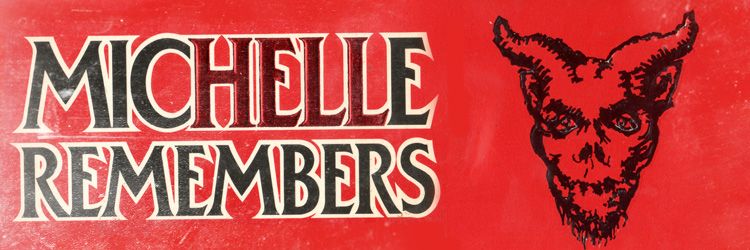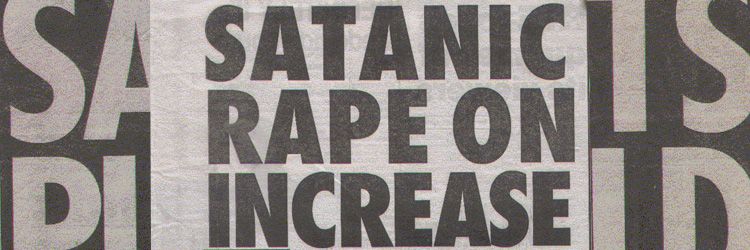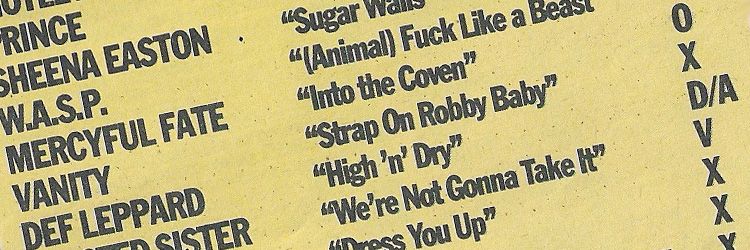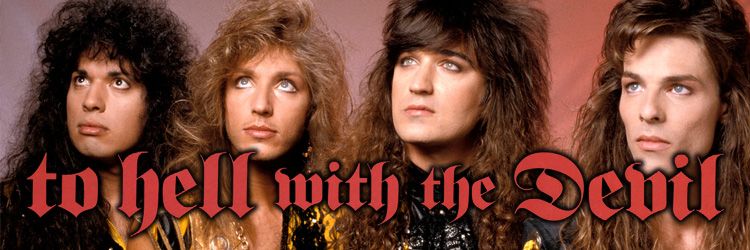In 1966, the advent of the Church of Satan would mark a shift in societal attitudes. Upon its creation, founder Anton LaVey declared “Annos Satanas,’’ – the first year in the “Age of Satan.’’ All of a sudden, a once feared, taboo belief system had ingrained itself in the public consensus, and its appeal extended to rock stars and celebrities whose participation in the movement would make it mainstream. However, the popularity of the Church of Satan was just one of a few countercultures shifting away from traditional, religious and wholly conservative attitudes. It is also worth noting that the Civil Rights Movement was ongoing, rock n’ roll music was massively popular and the hippies were spawning all over the world; particularly in America. The Church of Satan was merely a reflection of a society rejecting traditional values – well, a portion of society anyway.
With the rise of these movements came the response of the traditionalists who weren’t too pleased with the proposed change in norms. But the notion of Satanism was an especially terrifying one for them, to say the least. On top of the Church of Satan, the atrocities committed by Charles Manson and the Family helped instill a widespread fear of emerging countercultures across America. Throughout the 1970’s, Satanic panic was already being churned out by evangelists, but it wasn’t until the following decade where it would be given its label and become a catastrophic phenomenon.

In 1980, a book was published that would usher in a series of ritual abuse claims that would bedevil the decade. Co-authored by psychiatrist Lawrence Panzer and his patient Michelle Smith (whom the book is based on and he’d later marry), the faux-autobiography Michelle Remembers would bring allegations developed by religious fundamentalists pertaining to cults and ritual abuse to the forefront of mainstream media, and during the following years it would provide a model for similar cases to arise.
The book itself is just ridiculous. It documents Michelle’s “repressed’’ memories that were recovered during therapy sessions under Panzer. Most of the stories involve scenarios that wouldn’t feel out of place in a B-grade exploitation movie of the time period, and there are even cameos from Jesus, the Virgin Mary and Archangel Michael – who all appeared to save Michelle from a ritual attended by Satan himself. The holy trinity then erased her terrible memories and scars until the time was right. In 2016, Michelle Remembers would be dismissed as a horror pulp novel full of cheap schlock and outlandish fantasy, but back then it was accepted as clinical fact and used as a guide by law enforcement, courts, medical professionals and concerned citizens. In 1984, Pazder would serve as a consultant during the McMartin preschool trial, which would last for six years and – like his book – was debunked.
However, at the time, the McMartin trial sent alarm bells ringing throughout the country, as the accusations involved nursery children being sexually abused by day care workers who were supposedly part of a Satanic cult. Of course, such claims must be investigated, but the allegations also included witches flying on broomsticks and Chuck Norris being a member of the sect. When the trial ended in 1990 – with no criminal convictions made – it was the most expensive in American history. Michelle Remembers and the McMartin pre-school trial are perhaps the most famous reflections of the ritual abuse allegations which beset 1980’s with moral panic, but they weren’t the only circumstances to create Satanic anxiety throughout America, and naturally it spilled into pop culture – cinema, video games, board games, and of course, heavy metal music.

In the summer of 1984, 17-year old drug dealer and self-professed Satanist, Ricky Kasso, murdered his friend Gary Lauwers in the woods of Newport, New York while high on mescaline. According to the coroner’s report, Kasso allegedly stabbed his friend 36 times and sliced out his eyes, which led to media propagation that the murder was ritualistic in nature. Jimmy Troiano and Albert Quinones, who were friends of Kasso and Lauwers, were also present at the crime and told police that Kasso commanded Lauwers to say, “Say you love Satan” before he took his life; Lauwers replied with, “I love my mother.” For weeks following the murder, Kasso would lead local teens into the woods to show them the body and brag. He told some that he killed Lauwers because Satan told him to; he believed that the Devil had manifested in the form of a black crow, and when its caw coincided with Kasso asking if he should take Lauwers life, he interpreted it as Satan’s approval.
For months afterwards, the media presented Kasso as a Satanist who was part of a cult, further fuelling the hysteria that was engulfing America. The “Knights of the Black Circle” was supposedly the name of the sect Kasso had been a part of, although there was no evidence to suggest anything of the sort. A press release following the incident was released by Suffolk County Police claimed that Kasso regularly partook in rituals honouring the Devil; the notion that Kasso was a devil-worshipper was further backed up by his own father, who claimed his son was obsessed with reading about witchcraft and wearing apparel featuring Satanic symbols. On the day Kasso was arrested, he was wearing an AC/DC shirt for instance – and this led to the inevitable association between heavy metal and his atrocities by the media vultures, religious figures and concerned parents looking for a scapegoat. He would kill himself in prison under 48 hours later.
As Kasso was a heavy metal fan – particularly Ozzy Osbourne and Judas Priest – it didn’t take long for the association to be made. But it wasn’t the only atrocity to be linked with heavy music and the artists making it. In 1988, a Geraldo Rivera documentary called Devil Worship: Exposing Satan’s Underground aired which depicted metalheads as blood drinking, grave robbing, sacrilegious hooligans. It then went on to discuss a series of murders involving young people linked with devil-worship. The most notorious of them all was Thomas Sullivan, a 14-year old who stabbed his mother to death, and just so happened to be a fan of Black Sabbath (a common theme among the crimes of this ilk Rivera used for his agenda). Ozzy Osbourne would also appear as a guest via satellite, and when asked about the connection between his music and a number of the crimes that had been mentioned, he was more or less cut off before he could give a substantial defence.
https://www.youtube.com/watch?v=EcWbuBPNtPw
If anything, Exposing Satan’s Underground is a good starting point if you want to see every crime involving young people media could tie to Satan catalogued under the umbrella of propaganda television. There is no denying that some of the culprits were metal fans who just so happened to be fascinated with Satan, but issues such a mental health and home life were ignored in favour of sensationalist fear mongering.
The fear that heavy metal contained lyrics which encouraged people to do bad things was never the more prevalent in 1985 when 20-year old James Vance tried to sue Judas Priest. After a night of partying, Vance and his friend, 18-year Raymond Belknap, headed for a local playground and shot themselves. Belknap wouldn’t survive the incident, but Vance would and go on to file a lawsuit against Judas Priest as he claimed the subliminal messaging within their Stained Glass album drove him to the act. Ultimately, the band and their record label would avoid any legal responsibility for the tragedy, but not even empirical evidence was enough to convince concerned parents and moral campaigners that subliminal messages promoting suicide and devil-worship weren’t possessing the heavy metal records kids were listening to.

In 1985, a committee known as the Parents Music Resource Center, spearheaded by Tipper Gore, made up a playlist of songs they deemed inappropriate. The list, dubbed “The Filthy 15”, was used to serve as a template for proposed legislation regarding how albums should be rated, suggesting that they should come with extra warnings if the content pertained to sex, violence, drugs/alcohol or the occult. Of the fifteen songs, nine were metal, including: Judas Priest’s “Eat Me Alive,” Motley Crue’s “Bastard,” AC/DC’s “Let Me Put My Love Into You,” Twisted Sister’s “We’re Not Gonna Take It,” W.A.S.P’s “Animal (Fuck Like a Beast), Def Leppard’s “High ‘n Dry,” Mercyful Fate’s “Into the Coven,” Black Sabbath’s “Thrashed,” and Venom’s “Possessed.” However, what’s interesting is how much they failed to capitalize on the mass Satanic hysteria as much as they could have; for example, they chose an AC/DC song with sexual lyrics, as opposed to say, “Highway to Hell” or “Hell’s Bells,” which were two of the bands biggest hits, could be interpreted as occult-themed, and connected to Richard “Nightstalker” Ramirez, the Satanic serial killer whose murder spree terrorised the Greater Los Angeles until the summer of the year this hearing was held. The fact Ramirez also showed up to court with a pentagram carved into his own flesh should been enough to associate the band with Satanism.
That said, AC/DC didn’t escape the controversy of Ramirez’s heinous acts. Their song “Night Prowler” was accused of being an inspiration for Ramierz; even though the song is about a guy who sneaks into his girlfriend’s room at night when her parents are asleep for some canoodling, the scapegoat-hungry media pounced on the connection and threw the band to the wolves, content to blame them for something they had nothing at all to do with. Headlines even accused the band’s initials to mean “Anti-Christ/Devil’s Child” while they milked Ramirez’s fandom of the band for all it was worth.
Anyway, back to the “Filthy 15” fiasco. During the Senate hearings, some of metal and rocks most controversial figures at the time appeared to defend the genre’s honour. Frank Zappa appeared in a suit, while Dee Snider showed up looking like he’d just rolled out of a tour bus, only to shock – and anger – the court with his intelligent rebuts to their accusations. It’s a very entertaining watch to see Al Gore fuming at Snider’s criticism of the Declaration of Independence, when he claimed that was more violent than anything you’d hear on a Twisted Sister album.
King Diamond, on the other hand, was the personification of Satanic metal in the 1980’s. As a card carrying member of the Church of Satan, Mercyful Fate would never been given a fair hearing anyway. Their lyrics were heavily influenced by horror films and the occult, as were Venom’s. Neither artist took the PMRC seriously; in fact, they appreciated the publicity, and Venom jokingly said they weren’t looking hard enough if they thought that was the most offensive Venom song. In an interview with Sam Dunn for the 2012 documentary Metal Evolution: Extreme Metal, said [in reference to the list]: “That just sounds lazy to me. That sounds like nobody is listening to enough Venom to find the worst song.” In the end, a “Parental Advisory” sticker was agreed as the best course of action to take. However, while that is more than fair considering the lyrical content most of those songs isn’t appropriate for children, it does typify conservative attitudes held towards heavy metal at the time.
During the 80’s, MTV also fueled the moral furor by showing rock videos. In 1985, 20/20 aired a documentary called “Devil Worshippers”, which documented symbols associated with the occult. These included: the number 666, pentagrams, inverted crosses and all of the other images you’d expect from album covers of heavy metal bands since the genre’s inception. Of course, the theatrical nature of heavy metal videos at the time included this type of imagery; Iron Maiden’s, for example, “Can I Play With Madness?” shows a schoolboy stumbling upon a cult cloaked in black hoods, which was reminiscent of the Hammer Horror films of the 60’s and 70’s. To go back earlier, Ozzy’s “Mr. Crowley” shook parents up with its themes of vampirism portrayed erotically. These were typical of metal bands with a penchant for macabre entertainment and rebellion – and that’s all it was.
The content of these videos was nothing you wouldn’t find in a horror or fantasy movie, but back then they came under the hammer of religious group and censors. In 1983, the channel was banned in 1500 homes in Emporia, Virginia after a successful petition. It didn’t take long for the PRMC to get involved either; having successfully added sticker warnings to albums, music videos were their next target.
Backed by the Coalition on Television Violence, the PRMC campaigned for warnings to appear on screen when an inappropriate video appeared. MTV co-operated to avoid controversy, re-editing videos which included alcohol, drug use violence, sex and negative representation of certain societal groups. That said, they weren’t consistent with their agreement either, often showing videos which directly violated it. For example, the popularity of Michael Jackson’s “Thriller” was unavoidable, therefore it enjoyed constant airplay, much to the dismay of those who initiated the war on MTV. Eventually, the channel agreed to only play videos of this nature in late night slots; this led to the creation of Headbanger’s Ball in 1988, which played heavy metal videos in all their glory.

Moral panic had reared its ugly head in a myriad of pop culture entertainment. In addition to heavy metal, the hysteria also surrounded RPG’s, video games, comic books, cartoons and, of course, cinema. This coincided with the fact that the horror film industry was enjoying a boom throughout this decade; the advancement of practical effects meant that films could be gorier than ever, and new icons were born in the form of the slasher villain popularised through films like Friday the 13th, A Nightmare on Elm Street and Halloween. Therefore, it was only natural that a genre such as horror would collide with the furor, but surprisingly, not as much in America as the UK where the cusp of the controversy surrounding scary films was at its apex. The ‘Video Nasty’ films saw a censorship crackdown on horror and exploitation films deemed too violent or ‘harmful.’ Newspapers, like The Daily Mail, were directly linking these movies to real life violence and crimes among the nation’s youth, as well as declaring them damaging to intellectual growth.
Satanic hysteria would influence a host of horror films Stateside, however. Movies like Rockateer Blood (1984), Hard Rock Zombies (1985), Trick or Treat (1986), Rock ‘n’ Roll Nightmare (1987) and Black Roses (1988) were a reflection of the anxieties surrounding pop culture at the time. In these films, heavy metal was often portrayed as the root cause of evil and violence; for example, in Black Roses, a small-town teacher must save teenage souls from a heavy-metal rocker and his demonic band. In Trick or Treat, an alienated, bullied teenager discovers that he can communicate with a dead Satanic rock star when he plays his record backwards, and said rock star encourages vengeance against the bullies. These were the types of storylines which typified heavy metal horror films, which you could argue were merely trying to exploit the moral panic to boost ticket sales. That said, their tongue-in-cheek and camp factor also suggest that they were satirizing the outrage more than anything. One film that does poke fun at the hysteria which engulfed alternative pop culture during the 80’s is Lamberto Bava’s Demons, an Italian horror comedy which takes the idea that horror movies were the locus of violence, throws in a soundtrack containing some of the bands who were directly linked with conservative fears, and unleashes a hyperactive, gore-drenched free for all. In my essay for Diabolique, I examine the satirical aspects of Demons in greater detail. While not a ‘heavy metal horror film,’ Demons certainly knows how to rock.
Of course, metal wasn’t all devil worship back then. In fact, the heyday of bands promoting the gospel of Christ in their music was at its most popular during the 80’s. While most of us metal purists would agree that Satan has always been the inspiration behind the best tunes when it comes to metal’s theological aspects, artists who promote Christian themes in their music have existed for as long as metal has been around. When bands like Judas Priest and Ozzy were selling out stadiums based on sinister reputations, bands like Stryper were also a genre staple, and their message was very much the antithesis of worshipping a cloven hoofed goat man with a pitchfork. Metal will always be associated as being in more in league with the Devil than Him upstairs, but even during a period when Satanic fear was at its most prominent in regards to heavy music, there were bands out there showing that you could still embrace the ethos of metal and Christianity.
As the Satanic panic epidemic cooled down heading into the 90’s, the stigma attached to metal and devil worship was still causing a stir. For example, Marilyn Manson was a parental and religious nightmare in general, but when the Columbine tragedy happened he was vilified and used as a scapegoat. Much like Judas Priest, Ozzy and others were back years before, he was directly blamed for inspiring the crimes committed by Dylan Klebold and Eric Harris as they were fans of his music. Of course, Manson’s Church of Satan membership didn’t do his wholesome image any favours either. Even going into the Millennium, bands like Slipknot were building their reputation by being just as immersed in controversy as they were for their musical output. But during the 1980’s moral panic was directly linked to Satan and a genuine cause of anxiety for many a religious leader and parent – and it permeated throughout pop culture as a whole. There will always be controversy associated with entertainment, but at least nowadays society is a bit more understanding for the most part; excessive violence has become the lifeblood of some of television’s most popular contemporary programming, video games are becoming more gruesome as graphics evolve, and horror films have broken every taboo in the book to the point where every few bat an eyelid.
Scapegoating still follows metal around whenever it can – as it does other facets of pop culture – and it probably always will – but if Ozzy came along in 2016 dressed as a vampire singing about alchemists, most would brush it off merely as the daft fun it should have been in the first place. As science has advanced and we’ve gained a better understanding of mental health – with countless theories refuting entertainment as a direct cause of crime, violence, self-harm and lesser intelligence – it makes the Satanic panic epidemic seem quite ridiculous. But while we can sit back and laugh about Dee Snider defending metal in court nowadays, back then he was speaking to a panel who embodied a widespread mentality that actually existed – one which you could argue failed to comprehend logic. Sure, you could argue that society continues to baffle when it comes to logic in certain circumstances, but very rarely is the Devil blamed when it comes to contemporary outrage.